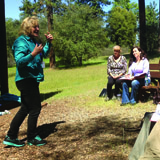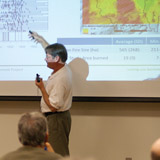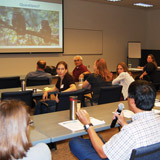Tintype photography by Michael Shindler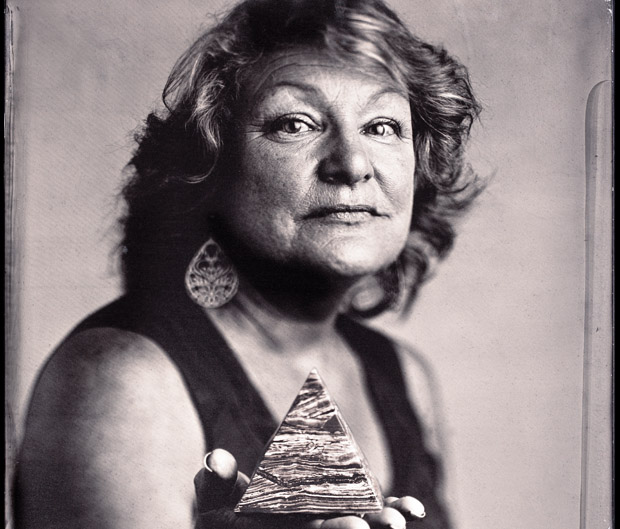
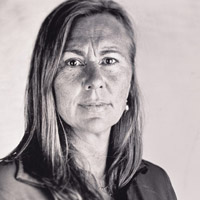
“You have to keep listening to your participants. These kinds of networks . . . can be fragile, but they can also be really strong if nurtured correctly.”
Maggi Kelly with her Trimble GeoXT GPS receiver, which collects data about her location in the forest.
The summer of 2002 was a bad fire season in the United States. Twice as many acres burned than in 2001, and more total acres were destroyed than in all but one of the previous 40 years. The McNally Fire in Sequoia National Forest was only the second largest fire in California that year, and it alone cost more than $50 million to extinguish. It was against this smoky backdrop that George W. Bush launched the Healthy Forests Initiative, a wide-ranging plan to reduce the severity of western wildfires.
In California, the plan coalesced around the concept of Strategically Placed Landscape Treatments, colorfully shortened to SPLATs. Mark Finney, PhD '91, Environmental Science, Policy, and Management (ESPM), a researcher at the Missoula Fire Lab in Montana, proposed that instead of thinning entire old growth forests, land managers could “treat” a fraction of the land with tree thinning and prescribed burns. These treated plots would slow a fire's rate of spread, acting like speed bumps along a road. It was an interesting but untested idea, and by 2004 the plan ran into bureaucratic roadblocks. Because while the federal government owns the national forests, the old-growth dwelling wildlife—fishers, goshawks, spotted owls—can fall under state or federal management, depending on the species. Closer to the action, the local communities of Foresthill and Oakhurst were concerned about large-diameter trees being cut as part of the thinning effort, and about the effect of prescribed burning on issues like home safety, wildlife, and water quality.
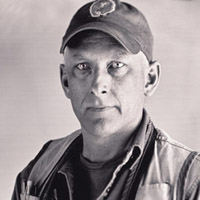
“All parties deeply care about the fate of these landscapes, and it was this care that sustained SNAMP for the long haul.”
John Battles with his logger's tape, used to measure distances and the diameter of trees.
It was beginning to look like then-Governor Arnold Schwarzenegger, a Republican and a self-professed environmentalist, was going to sue the Bush administration over its forest policy mandates—an expensive, bitter process that nobody relished. Instead, a novel approach was conceived: The U.S. Forest Service agreed to test the unproven SPLAT approach along with state agencies, like Fish and Game, Department of Water Resources, and Cal Fire, as long as a neutral third party could be tasked with analyzing the results. And that third party would be the University of California.
And thus, the Sierra Nevada Adaptive Management Project was born, with another endearing acronym, SNAMP. Today, as SNAMP reaches the end of a 10-year run, the project has proven to be a multidisciplinary, multiagency, multimedia success that has the potential to transform not only how we view forest fires, but more intriguingly, how scientists, government agencies, and public stakeholders interact in the pursuit of common goals.
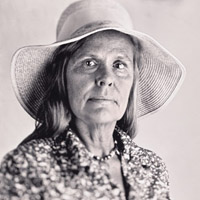
“The stakeholders ended up influencing the kinds of research questions that the scientists asked.”
Lynn Huntsinger with her ever-present clipboard
“Honestly, nobody wanted to do this,” recalls John Battles, a professor of forest ecology and the chair of ESPM's Ecosystem Science Division. “It seemed like it was going to be a quagmire of wasted time.” Take the always contentious issues of fire, water, and wildlife, then add in an alphabet soup of local, state, and federal agencies, and it's easy to see why most academics would keep their heads down and hope not to be called upon. But the governor was looking to the UC system to step up, and Battles, as head of Berkeley's Center for Forestry, felt that he could not refuse. “That's what we do,” he says. “That's the stuff that we should do.”
Gradually, a plan took shape. With the ultimate goal of moderating fire behavior, the U.S. Forest Service would conduct prescribed burning and tree thinning as they saw fit. It would then be up to UC scientists to study the results—not just in terms of fire, but also the impact on wildlife, water, and forest health.
Working with Stakeholders
Modern adaptive management takes into account complex factors—climate change, human impact, a century of fire suppression, marijuana farms on federal lands—requiring forest managers to continually adapt their strategies to new information, new methods, and new facts on the ground. Even so, a traditional study of various fire treatments would have been fairly straightforward: Do a range of experiments, analyze the results, publish some papers.
But SNAMP's goals went far beyond simply figuring out the best way to slow a wildfire's spread. The experiment proceeded along parallel tracks, studying fire, forest health, fishers, owls, water quality issues, and spatial data. And crucially, public participation wasn't an afterthought or an also-ran, but the key piece of the puzzle. According to Kim Rodrigues, PhD '08 ESPM, a UC Cooperative Extension regional director at the time, “The overall goals of public participation are efforts to reduce conflicts around resource management on the ground.” Rodrigues focused on figuring out how to make public participation more meaningful and relevant.
While the Endangered Species Act and the National Environmental Policy Act both require public comment periods, actual community participation is often disappointingly low. “You really can't just pay lip service to interaction when you have contentious issues,” says Maggi Kelly, Geography '88, an ESPM professor and Cooperative Extension specialist who is a principal investigator (PI) of SNAMP's Public Participation Team as well as its Spatial Team. “You have to dive in and do it in a committed way. You have to keep listening to your participants. These kinds of networks and coalitions can be really fragile, but they can also be really strong if nurtured correctly.”
How to best engage the public was an open question. The team eventually settled on a simple strategy: try everything. Kelly and others created a comprehensive, interactive website stuffed with videos, summaries of scientific findings, and a huge trove of documents available for scientists, agency employees, and any member of the general public who took an interest. Perhaps the best feature was the discussion section, where people submitted questions about topics as varied as fuel break maintenance, government intrusion onto private lands, and the affects of the Native American practice of gathering pine roots. The questions received thorough responses from the team members, a level of public engagement that's truly unusual for scientists who are more accustomed to responding only to peer reviewers.
The website was moderately successful. “But our stakeholders really prefer face to face,” says Kelly, so her team ramped up its in-person efforts. Extension agents who lived in the affected communities of Oakdale and Auburn made themselves available for public questions and concerns at board of supervisors meetings, PTA gatherings, and fire-safe councils. Beyond the standard bad-coffee talkathons, the scientists also held field trips to show these theoretical issues in action.
“Anyone can talk about ‘resilient forests,'” Rodrigues says, “but if you go to the Rim Fire [the massive 2013 Yosemite blaze] you can operationalize these terms. You can show someone that this is how a high-severity fire sterilizes the soil.” And the learning went both ways, according to Lynn Huntsinger, MS '82 Rangeland Science, PhD '89 Wildland Resource Science, an ESPM professor recruited by Battles for her experience working with landowners. “I've seen management programs in the past where scientists don't come to meetings and face stakeholders,” she says. “But in this case, the stakeholders ended up influencing the kinds of research questions that the scientists asked.”
Research in a Fishbowl
For the scientists, the entire process was occasionally frustrating as well as eye-opening. With the Forest Service creating the treatment plans, the PIs didn't have the same experimental control that they might have had on UC-owned land. And not only did the researchers have to learn how to share their results with lay audiences, they had also committed to sharing their results with the public on an accelerated pace, before everything was in its final form and ready for publication. “It's risky work doing research in a fish bowl,” says Rodrigues, now the executive director of academic personnel at UC's Division of Agriculture and Natural Resources. “Scientists don't like to be questioned, especially by non-scientists. And this team was questioned by the public, by team members, by managers.”
To start things out on the right foot, the entire UC team signed an explicit Statement of Neutrality. While acknowledging that such impartiality is difficult after a career spent studying the exact issues at hand, Battles quickly came to see how valuable neutrality was. Many of the participants from both management agencies and environmental groups had long and contentious histories with each other, often on issues unrelated to SNAMP.
“You really had to listen, just say your piece, and then not repeat it,” said Battles. “People would come to our meeting who had been cross-examining each other in court the day before. But our meetings had different rules, and they became a safe haven.” Many of the regular participants were employees of environmental organizations, the very people who—for better or worse—often make life difficult for professional land managers. And yet, just having them at the table, engaged in dialogue, helped to defuse tensions at an early stage.
Amid all the great meta-research going on, hard scientific questions were still being asked, specifically: Does treating a fraction of the land have significant effects on the rate of fire spread? The answer seems to be yes. “The best outcome,” according to Battles, “is to have no treatment and also no fires. But you're just rolling the dice then. One percent of the landscape burns every year, and with climate change, that's going to increase. Are you willing to live with that? What if it goes to 2 or 3 percent?”
While the SPLAT speed-bump idea has proven effective, implementing it more widely is not a slam dunk. According to Forest Service ecosystem management director Deb Whitman, “In reality, it's hard to implement the way it was designed.” Managers must consider more than just fire spread when they lay out treatment plots. If a plot of land designated for clearing falls on an archaeological resource or a spotted owl nest, the ideal herringbone pattern of treatment must be adjusted.
Scaling Up
SNAMP has become a model for engaging the public on land management issues, but the resources simply aren't there to spend 10 years and $12 million—the timeframe and budget allotted to SNAMP—every time a forest must be thinned. By some estimates, if you extrapolate the current rate of fuels treatment over the next 30 years, as much as 60 percent of the land that needs treatment won't get it. “That's a nightmare scenario,” says Scott Stephens, PhD '95 Wildland Resource Science, a PI on the Fire Team. “Take the Rim Fire forward in an era of warming climate, and that's really unacceptable.”
More prescribed burning and thinning means more need for the stakeholder participation that has been SNAMP's hallmark. “We can't have a science team or a Cooperative Extension team at every site,” says Rodrigues, but her team now offers train-the-trainer seminars to teach community groups, agency representatives, and others how to lead collaborative group discussions, facilitate diverse groups, work through conflicts, document key agreements, and other skills. According to Christine Nota, the Regional Foresters' representative for the Forest Service, the techniques used in SNAMP “are very common now throughout our forests. We were just counting up forest-based collaborations, and I think we've got 17 or 18 scattered around the state.”
Even better, it seems that the tools used to talk about prescribed fires are applicable to other areas where public concern is high, issues as varied as youth development, water conflicts, and even urban housing disagreements. “I really wish I'd had this kind of experience and training when the spotted owl was listed in the '90s,” Rodrigues says ruefully. “Maybe we could have gotten better dialogue much earlier on.”
One point of general agreement that saw all SNAMP's constituencies through difficult times was that the forests of the Sierra Nevada are worth working to protect. “All parties deeply care about the fate of these landscapes, and it was this care that sustained SNAMP for the long haul,” Battles says.
Another key consensus was that being in the middle of this chaotic process is exactly where UC needs to be. Faculty members love to dive deep into theory and advanced research, but the essential framework of a land-grant institution will always be mission oriented, a quest to solve concrete problems on the land. “I'm not a Forest Service employee, and I don't work for an advocacy group,” Battles says. “And that's the pitch for the public university. You have the independence. You can speak to power. And when the state asks for your help, you say yes.”
